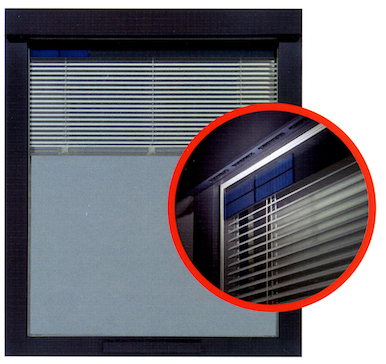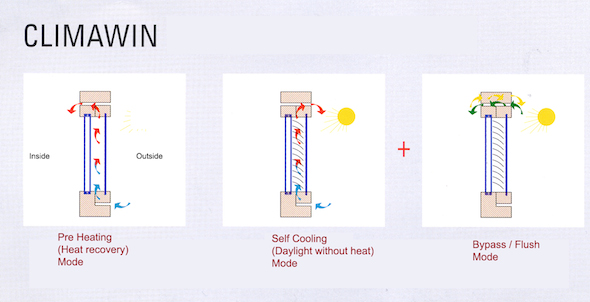A consortium of three European manufacturers and suppliers of windows and ventilation systems has created a new technology for energy efficient heat recovery windows for the renovation of residential and commercial buildings. In winter, windows and ventilation are a significant source of heat loss, particularly in older buildings, and the new windows address this. The smart CLIMAWIN windows also have a self-cooling function suitable for hot weather, reducing the need for expensive air conditioning, making them suitable for all climates.
How it works
“Windows are a huge source of heat loss in a building. Our innovation is effectively a passive heat recovery ventilation system. Test results show that a standard building fitted with CLIMAWIN windows only, would improve its energy performance by 18-24%,” said project representative Brian O’Brien, of Solearth Ecological Architecture.

He continued: “In cool climates, CLIMAWIN is designed to improve comfort by pre-warming ventilation air on the north, east and west facades, and by using solar gain on southern facades. For hotter climates, it has a self- cooling function that allows daylight in, but reduces the unwanted solar heat. Through optimising thermal insulation, solar energy gains and daylight control, the window is expected to significantly improve energy efficiency and thermal comfort in both residential and commercial buildings that do not currently have efficient ventilation systems.”
The window was developed by seven partners from four countries – Denmark, Germany, Ireland and Portugal – in an EU-funded research and development project called CLIMAWIN. The high-performance window pre- heats incoming ventilation air, powered by solar cells and is regulated automatically from room sensors. It has numerous features which give it clear advantages over existing window and ventilation technologies. These include very high thermal insulation, regulated vents for controlled air intake, a frame of two layers of glazing, air filters, integrated electronics and wireless communications between room sensors and the windows (so retrofit installation can be done without rewiring). There is both pre-heating and a self-cooling functionality for different climates and a flush/bypass mode for extreme conditions.

A global business opportunity
The technology was three years in the making and is now being launched commercially by three of the project partners. CLIMAWIN windows will be available across Europe by late-2014. Producers will also be able to buy a licence from the consortium to integrate CLIMAWIN technology into their own production with royalties paid to the consortium. Beyond Europe, the consortium anticipates an important market in the US, Canada and Russia.
Michael Jennings, spokesman for European Research, Innovation and Science Commissioner Máire Geoghegan-Quinn, said: “CLIMAWIN shows that low carbon can also mean big business opportunities for SMEs, which are the backbone of our economy. These kinds of technologies will also help consumers and businesses by reducing energy bills. The EU will support even more of this kind of research in our new Horizon 2020 programme.”
About CLIMAWIN
CLIMAWIN is an advanced (heat recovery) ventilation window system developed by Solearth Architecture in Dublin, Ireland, Rauh Fensterbau in Sassendorf, Germany and Horn Vinduer in Lunderskov, Denmark with R&D by Fraunhofer Institute, Aalborg University, Denmark and The Electronics Department of the University of Minho, Portugal following an EU-funded research project in 2012. Altogether the project partners will have received €1.4million in EU budget money by the end of the current 2nd project.
The CLIMAWIN project was primarily aimed at the renovation sector, especially of older buildings in which energy efficient ventilation systems are rare. Thanks to its dual ability to optimise indoor air quality and maximise thermal efficiency, the CLIMAWIN window is expected to be a component in encouraging the uptake of near zero-energy buildings (or passive houses).
CLIMAWIN ventilation windows will be available across Europe in late 2014 in wooden, wood composite aluminium and aluclad version manufactured in Denmark and Germany. The system is marketed through www.climawin.eu . CLIMAWIN is interested in developing licensing partnerships with window companies who wish to incorporate CLIMAWIN technology and know-how in their product catalogues.
About European research and innovation funding
On January 1st the European Union launched a new, seven year research and innovation funding programme called Horizon 2020. Over the next seven years nearly €80 billion will be invested in research and innovation projects to support Europe’s economic competitiveness and extend the frontiers of human knowledge. The EU research budget is focused mainly in improving everyday life in areas like health, the environment, transport, food and energy (see table breakdown below). Research partnerships with the pharmaceutical, aerospace, car and electronics industries also encourage private sector investment in support of future growth and high skill job creation. Horizon 2020 will have an even greater focus on turning excellent ideas into marketable products, processes and services.